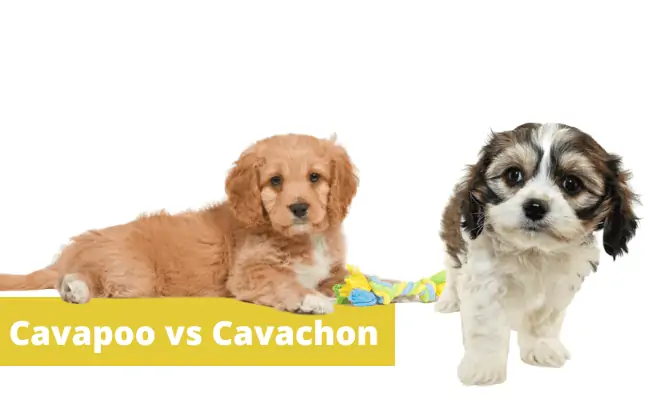Last Updated on
At first glance, differentiating between a Cavapoo and a Cavachon is quite difficult. Both breeds look the same, but there are some significant differences between these crossed breeds.
The Cavachon and Cavapoo have one parent in common: the Cavalier King Charles Spaniel. The other parent of the Cavachon is a Bichon Frise, while a Cavapoo is the offspring of a toy poodle or miniature poodle.
If these cute pups have stolen your heart and you want to get home any one of these puppies, you should know more about their characteristics, temperament, and health issues.
Let’s get started and find out which dog breed will be perfect for your home.
A Quick Comparison Of Cavapoos vs Cavachons
| Cavachon | Cavapoo |
| Up to 13 inches | Up to 14 inches |
| Up to 35 pounds | Up to 25 pounds |
| 10 to 15 years | 12 to 15 years |
| Wavy/curly (medium length) | Wavy/curly (usually short) |
| Affectionate, playful, gentle | Smart, affectionate, active |
| While, black, blue, apricot, brown | Golden, caramel, cream, black |
What Is A Cavapoo?
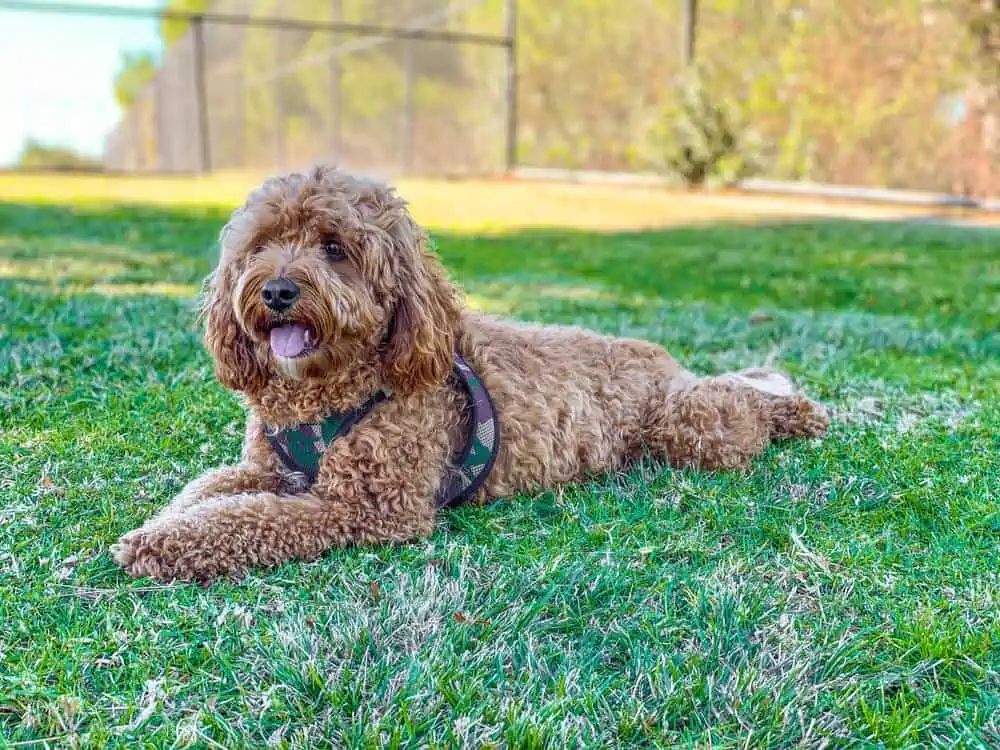
The Cavapoo is a mix between a Cavalier King Charles Spaniel and a miniature Poodle. Both are popular dog breeds that have been bred for years.
The Cavalier King Charles Spaniels is a British toy breed similar to Spaniels. It’s quite an old breed with lots of energy.
Cavalier King Charles Spaniel doesn’t like to sit at the corner of a house, begging you for some belly rub. It loves playing around and has hunting instincts as well.
It’s an athletic breed that loves hiking, running, and other dog sports like frisbee and rally.
Cavalier King Charles Spaniels are found in black, ruby, and tan colors. Sometimes a mix of three colors like black, white, and tan. Blenheim (chestnut and white) is another coat color in which we see Cavalier King Charles Spaniels.
Poodles are also a very popular breed. Poodles were originally bred in Germany as duck hunters. They are super energetic, affectionate, and love spending time with their owners.
It’s not very clear when people started breeding Cavapoos, however, some assume it’s a 90s breed that originated in Australia.
Cavapoos are small designer dogs with lots of energy. They love playing around and show a lot of affection for their owners. They are suited for an active family who can spare time to play with them daily.
Due to their overexcited nature, Cavapoos may not be the best choice if you have small kids. Even though they are very affectionate with kids, there are chances of accidents because of their bouncy nature.
The best part about Cavapoo is that they are highly adaptable to any environment. Whether you live in a small apartment or a big house, they will have no problem adjusting.
Further, Cavapoos are the best dog breed to own if you have a multi-pet house. They are friendly with other pets, provided you opt for early socialization.
What Is A Cavachon?
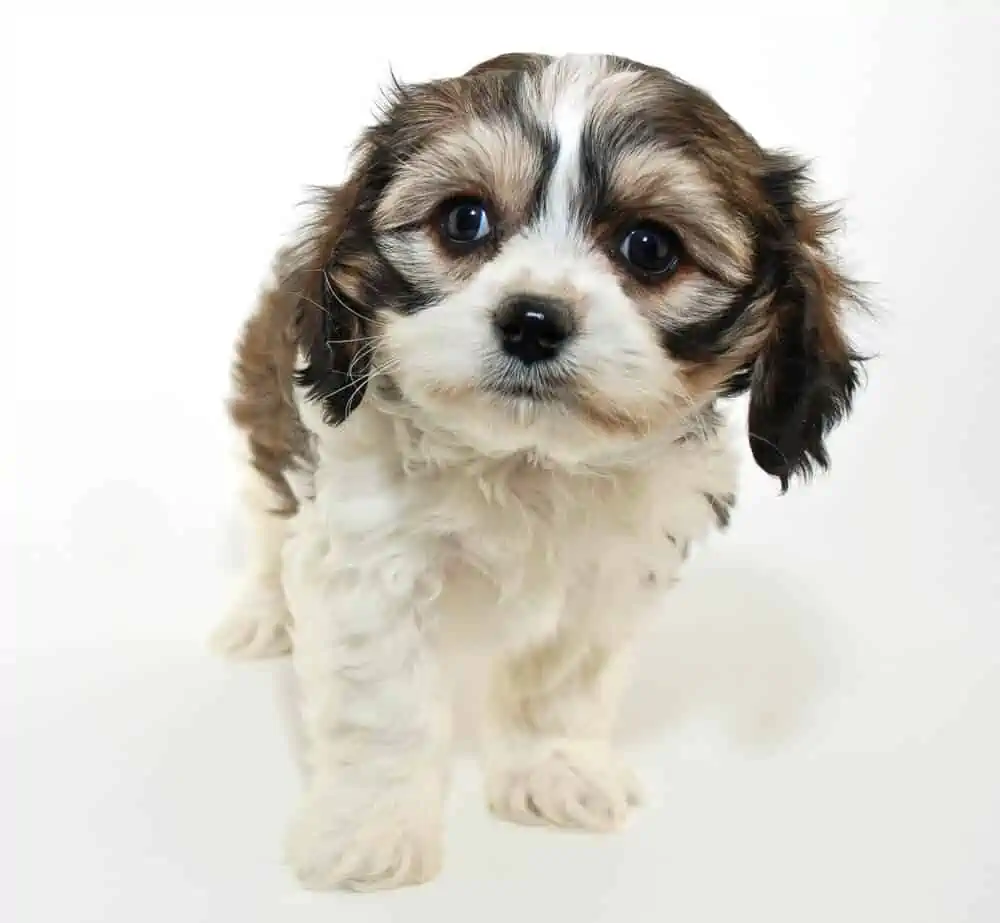
As mentioned, a Cavachon is a hybrid breed. It’s an offspring of Cavalier King Charles Spaniel and Bichon Frise. Cavachons will inherit the traits of both the parent breeds; hence, knowing the parent dogs’ background is essential.
I have already discussed the traits of Cavalier King Charles Spaniel while talking about Cavapoos. So let’s now take a brief look at the breed history of Bichon Frise.
Bichon Frise looks very similar to Poodles with their fluffy coat with a curly outer layer and a soft undercoat.
Bichons are an ancient breed dating back to the Middle ages. They were bred as companion dogs due to their friendly nature and cheerful temperament.
They are loyal and gentle and get around easily with other dogs or pets as well. Bichons also don’t bark a lot and can adjust quickly to apartment life.
Due to their fluffy coat, Bichons require regular grooming, trimming, and bathing. Bichon Frise is generally considered a hypoallergenic dog.
Although no dog can be 100% hypoallergenic, some people find their allergies are less severe around these types of dogs.
The mixed breed of Bichon Frise and Cavalier King Charles Spaniel, the Cavachon is a relatively new breed. It first appeared in America around the 1990s and has rapidly won the heart of dog lovers.
Like the Cavapoos, Cavachons are also a small breed. They do not weigh more than 18 pounds and grow not more than 14 inches.
Cavachons have soft, silky, wavy coats and lighter color bodies mostly due to the White Bichon Frise parent. But they can also have black, apricot, and tan markings.
These hybrid dogs have a gentle and more laid-back nature. Therefore, they love living in a tranquil or peaceful environment.
Cavachons are the best pet to own if you live alone or have a tiny family. Cavachons are not a big fan of a loud, busy lifestyle.
Now that you are familiar with the basic characteristics of Cavachon and Cavapoos let’s see the difference between them.
Cavapoo vs Cavachon: What Are The Primary Differences?
Following are the primary differences between these mixed dog breeds that will further help you decide which dog breed you should bring home.
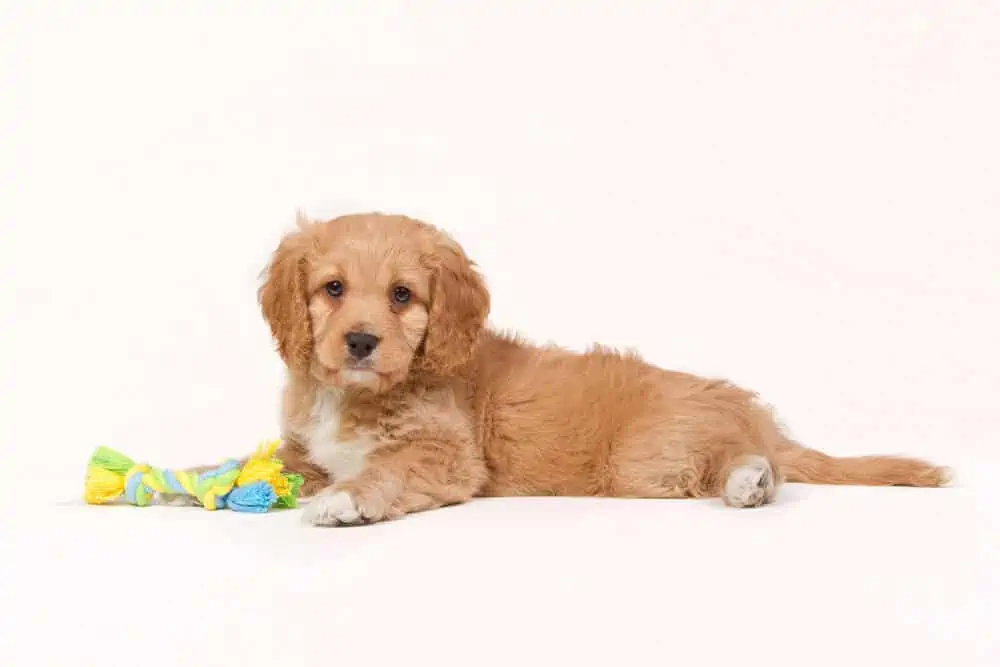
Cavapoo vs. Cavachon: Size & Appearance
There aren’t significant differences when it comes to the size. Both the Cavachon and Cavapoo are small dogs. The Cavachons can weigh 20 to 35 pounds and grow up to 13 inches.
Cavapoos, on the other hand, weigh up to 25 pounds and grow about 14 inches. The size of the Cavapoo mainly depends on the Poodle parent.
If the Cavapoo is bred from a miniature Poodle parent, it’ll be slightly bigger in size, and if it’s from a toy Poodle, it will turn out to be even smaller than the Cavachon.
Cavapoo vs Cavachon: Color & Coat
When it comes to looks, these miniature dogs have some noticeable differences.
Cavachons have a soft and silky coat. They have medium-length straight coats as their parent breeds also had straighter coats.
The Cavapoo has a curlier coat inherited from the Poodle parent. A Cavapoo can have three different coat varieties like wool, fleece coat, or soft and silky coat, which is quite similar to the Cavachon.
Cavapoos are found in multiple colors like black, white, tan, apricot, etc. As I mentioned, they come in a mix of different shades.
Cavachons have lighter bodies as a descendant of Bichon Frise. But they have a darker tan, apricot, or black markings around their bodies.
Both two breeds have darker eyes and floppy ears. Both of these dogs are super adorable and will immediately melt your heart.
Cavachon vs Cavapoo: Temperament
Figuring out the temperament of mixed breeds at an earlier stage may be a bit difficult.
While most of the time, they carry the genetics of both parents, sometimes, the presence of one parent comes out stronger.
But as per reputable breeders, Cavapoo and Cavachon puppies are affectionate and friendly dogs. But the Cavapoo is more active, while the Cavachon has a laid-back nature.
As an offspring of the Poodle, Cavapoo is a very bouncy and active dog that always loves to play and stay engaged with something or the other.
Due to their high-spirited nature, Cavapoos are best suited for active families. They require dedicated play and exercise time, without which your pet can turn destructive.
Poodles were bred as hunting dogs making them super active. The presence of Poodle genetics in the Cavapoo can be clearly visible, which is why Cavapoo owners must have some knowledge about controlling them and diverting their energies in the right direction.
Cavachons are also great family pets. A Cavachon puppy is not as active as the Cavapoo.
It’s an easy-going and relaxed breed as both its parents are calm dogs.
Cavachon dogs love a quiet or tranquil environment. Therefore, they are best for families with less chaos or the hustle and bustle.
A Cavachon puppy is an adorable companion who will shower you with love, affection, and loyalty.
Since Cavachons are very gentle, they can easily get around with kids and other pets. However, you must keep a watch if you let your pup play with your kid.
Cavapoos are also great around other dogs. But I won’t recommend them to families with infants.
No, they won’t willingly harm your baby, but due to their hyperactive nature, there might be unwanted accidents.
Cavachon vs Cavapoo: Training & Exercise
From the nature of both the Cavachon and the Cavapoo, you must have got an idea of their training & exercise requirements.
The Cavapoo puppy won’t let you sit ideally. Like Poodles, it needs lots of exercise and training.
You have to spend at least an hour daily to keep them engaged. They will quickly get bored if you don’t engage with them a lot.
Go for a long morning walk; if you can manage time, an evening walk will keep your pup super happy.
Apart from this, they need mental stimulation exercises like an obstacle course, teaching them new tricks, playing hide & seek, etc.
Do some obedience training as well to avoid unpleasant incidents in public.
I know it’s not possible to play with your pup all the time; hence, bring them some dog toys to keep them engaged during the day.
Cavachons don’t need as much exercise as a Cavapoo dog. However, going for thirty minutes of walking daily will keep your pup happy.
Teaching basic dog tricks to all breeds, irrespective of how active they are, is always fun.
Less active hybrid breeds like Cavachons love to snuggle with their owner; if they don’t receive pats or get enough snuggle time, they may suffer from separation anxiety.
The best thing about both the Cavapoo and Cavachon puppies is that they can easily adapt to small and large houses.
Furthermore, these cute pooches are highly intelligent, smart, and quick learners.
Cavachon vs Cavapoo: Grooming
Cavachons are not high-maintenance dogs. They do fine with average grooming. Brushing them two to three times a week is enough to keep their fur healthy and manageable.
You should bathe them using good quality dog shampoo once or twice a month. Clean their teeth and ears well to keep them infection free.
In contrast, you need to brush your Cavapoo puppy every day. It has a thick curly coat which requires maintenance. The curls easily get tangled if you don’t brush them for two-three days.
Bathing the Cavapoo once a week is a must. I would recommend taking it to a professional groomer to keep your designer dog in the best shape.
Because of their floppy ears, Cavapoos are prone to ear infections. Hence, taking it to a dog groomer every 4 to 6 weeks is a must to keep your pup healthy and clean.
Both Cavachon and Cavapoos are low-shedding dogs meaning you won’t find much dog hair around your home. Some also say that these are hypoallergenic dogs, but no dog can be 100% hypoallergenic.
And because the Cavapoo and Cavachon are half Cavalier King Charles Spaniel (which is not classified as a “hypoallergenic” dog), there’s a chance that the Cavachon and Cavapoo won’t be low-shedding or suitable for someone with allergies.
Allergy sufferers are also allergic to the dog’s urine and saliva. So, a low-shedding dog might help someone with allergies, but it may not.
If you have allergies, you should speak with an allergist before getting a dog so you can decide whether or not it’s the right choice for you.
Cavachon vs Cavapoo: Nutrition
Always go for high-quality dog food free from chemicals and preservatives. Consult your vet regarding which dog food will be best for your pup.
Please note that both these breeds are predisposed to obesity, so avoid feeding them more than the recommended portion.
Cavachon vs Cavapoo: Health Issues
Hybrid puppies are less prone to genetic diseases than purebred dogs. But we can’t say they are immune to any diseases, and mixed breeds may also catch genetic diseases, especially when poorly bred.
Some of the common diseases or disorders seen in both the Cavachon and Cavapoo puppies are-
- Hip Dysplasia: a disease caused by abnormal formation of hip and elbow joints. If not treated early, it continues to swell and evolve.
- Luxating Patella: Cavapoo dogs are more prone to Luxating Patella. This disease is also known as kneecap dislocation. If you see your canine walking on three legs, it’s a sign your pup might be going through the disease. It can be extremely painful so taking medical help is a must.
- Atopic Dermatitis: a skin allergy that causes itching. If you notice your dog constantly scratching its body parts, it’s a sign of Atopic Dermatitis.
- Eye Disease: Cavapoos are more prone to eye diseases like Progressive Retinal Atrophy. It quickly blurs the vision and, if it goes untreated, may make your dog blind.
- Heart Defects: Cavachons and Cavapoos may also catch heart diseases like Mitral Valve disease. Regular vet checks are recommended to keep this illness at bay.
Cavapoo vs Cavachon: Price Difference
Hybrid dogs are usually pretty expensive. Breeding them involves lots of care, patience, and expenses; hence if breeders levy high charges.
Cavapoos are generally more expensive than Cavachons as they are more in demand than the latter. Cavapoo prices start from $1,000 and may go up to $2,000.
In contrast, you can get a Cavachon puppy for $500, but the prices may go as high as $1,000.
It’s best to buy mixed breeds from a reputable breeder. Don’t buy them from unscrupulous puppy mills. While they may sell these dogs at lower prices, they exploit the parent breeds only for breeding purposes.
You can also check out dog rescues to see if there is a Cavalier hybrid dog available for adoption.
Final Thoughts
Cavachons and Cavapoos are both amazing dogs with lots of affection for their owners. I hope this detailed guide on the difference between these two breeds has helped you decide which dog you want to take home!
Yes, Cavachons and Cavapoos are both good family pets. While the Cavapoo is best suited for active families, Cavachons prefer a low-key lifestyle.
Yes, Cavachon and Cavapoos live with other pets, but early socialization and dog training are necessary to avoid territorial behaviors.
No, Cavachons and Cavapoos are not very high-maintenance breeds. They only require regular brushing to keep their fur healthy and free of tangles. Taking them to a professional groomer once a month is recommended.
This article may include affiliate links. www.travellingwithadog.com is a participant of Amazon.com Services LLC Associates Program. As an Amazon Associate, I earn a commission from qualifying purchase. www.travellingwithadog.com participates in other affiliate programs, and recieves commissions when purchases are made through the links. The cost is not inflated to account for the commission earned.
Veterinary Disclaimer: travellingwithadog.com is not a substitute for veterinary advice and does not intend to provide any type of veterinary advice for your animals. Please consult your vet for any questions you have regarding your pets health.
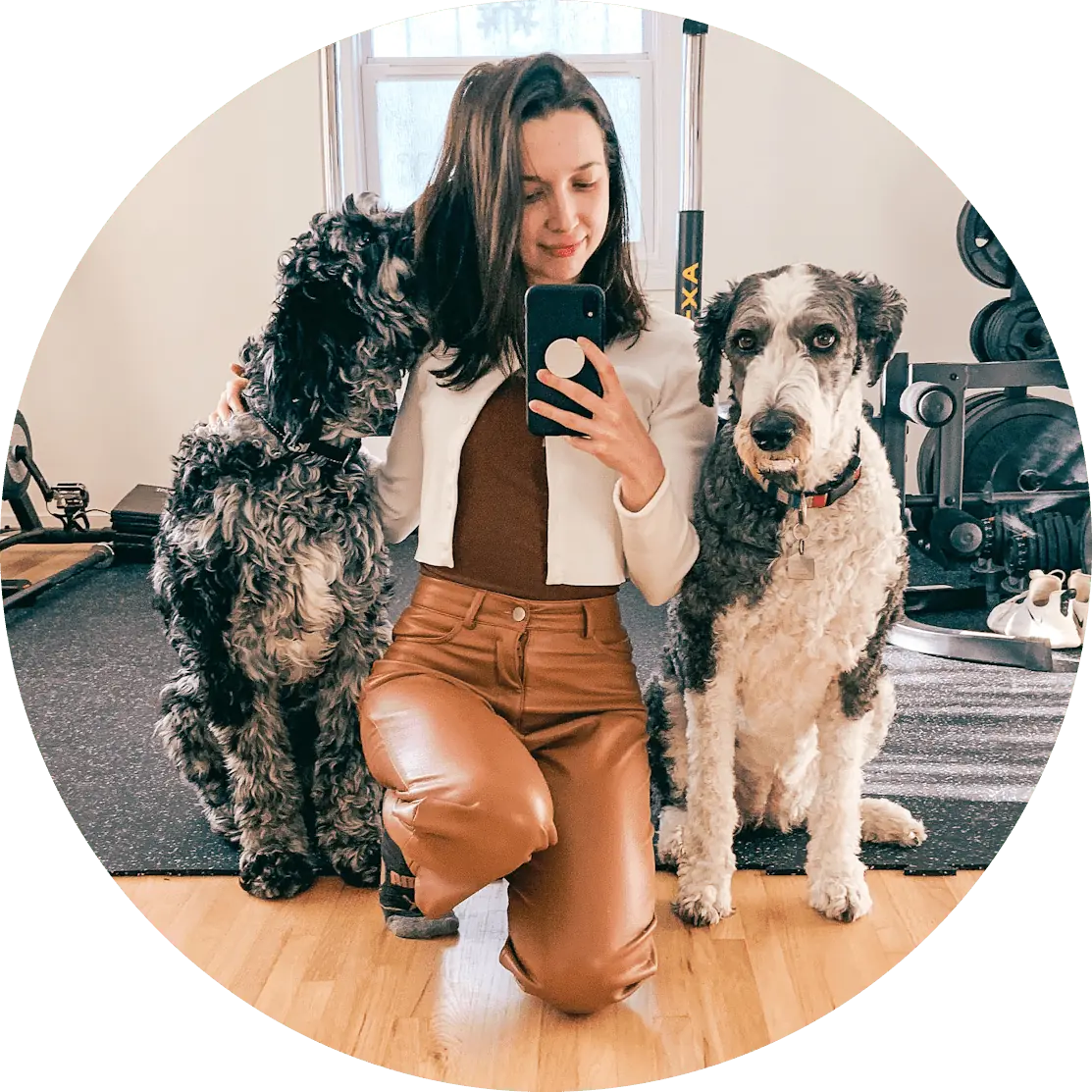
About the Author:
Dana owns a Sheepadoodle and a rescue merle Labradoodle. Her first dog growing up was a white Toy Poodle and she’s loved dogs ever since. She has years of experience fostering dogs and has helped find homes for a variety of different breeds, both large and small! After seeing so many dogs end up unwanted and in shelters, she began blogging about different dog breeds (specifically Doodle dogs, since that’s what she knows best) to help people make informed choices when adding a new member to their family.
When Dana’s not brushing her Doodles’ hair (it takes a lot of time for two!) you can find her playing nose work games and fetch with her two amazing pups.
Learn more about her here.

